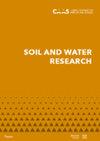高寒草原开垦条件下土壤有机碳及其组分的变化
IF 1.7
4区 农林科学
Q4 SOIL SCIENCE
引用次数: 0
摘要
草地是中国主要的土地利用类型,但开垦成农田会影响陆地碳,从而影响全球碳平衡。高寒草原长期开垦为农田有望降低土壤有机碳(SOC)及其含量。在这里,我们进行了一项原位系统研究,以测量种植历史为0至40年的高寒草原土壤中SOC及其分数。开垦后SOC及其分数显著降低(P<0.05),其中0~20cm土层的变化在三个采样深度中最大。经过40年的开垦,0–20厘米处的SOC含量和储存量分别下降了74%和60%。土壤不稳定碳组分的下降比SOC更快、更明显,尤其是特定有机碳(POC)下降了82%。土壤腐殖质碳组分也有所下降,特别是腐殖酸碳组分下降了81%。SOC及其组分的降低率随着栽培历史的增加而逐渐降低。此外,腐殖酸(HA)和黄腐酸(FA)溶液在465和665nm处的光密度或吸光度之比(E4/E6比)以及溶液中HA(FA)物质在400和600nm处的吸光度之间的对数差异即色调系数(Δlog K值)逐渐降低,表明土壤腐殖质的质量下降。开垦显著降低了高寒土壤的SOC及其分数,从长远来看,这对陆地碳循环和平衡的影响不应低估。本文章由计算机程序翻译,如有差异,请以英文原文为准。
Changes in soil organic carbon and its fractions under grassland reclamation in alpine-cold soils, China
Grasslands are the main land use types in China, but their reclamation into croplands can influence the terrestrial carbon and, consequently, impact the global carbon balance. The long-term reclamation of alpine-cold grasslands to croplands are expected to decrease the soil organic carbon (SOC) and its fractions. Here, we conducted an in situ systematic study to measure the SOC and its fraction in soils sampled in an alpine-cold grassland with a gradient of cultivation history from 0 to 40 years. The SOC and its fractions significantly decreased after reclamation (P < 0.05), and the changes in the 0–20 cm soil layer were the greatest among the three sampling depths. After 40 years of reclamation, the SOC content and storage at 0–20 cm decreased by 74 and 60%, respectively. The decreases in the soil labile carbon fractions were more rapid and apparent than the SOC, especially the particular organic carbon (POC), which decreased by 82%. The soil humus carbon fractions also decreased, particularly the humic acid carbon (HAC), which decreased by 81%. The reduction rates of SOC and its fractions gradually decreased with an increase in the cultivation history. Besides, the ratios of the optical densities or absorbances of humic acid (HA) and fulvic acid (FA) solutions at 465 and 665 nm (E4/E6 ratios) and the hue coefficient (Δlog K values), which is the logarithm disparity between the 400 and 600 nm absorbance of the HA (FA) substance, in the solution gradually decreased, indicating that the quality of the soil humus decreased. The reclamation significantly decreased the SOC and its fractions in the alpine-cold soils, which should not be underestimated in the impact on the terrestrial carbon cycles and balance in the long run.
求助全文
通过发布文献求助,成功后即可免费获取论文全文。
去求助
来源期刊

Soil and Water Research
Water resources, Soil Science, Agriculture-WATER RESOURCES
CiteScore
4.60
自引率
0.00%
发文量
26
审稿时长
>12 weeks
期刊介绍:
An international peer-reviewed journal published under the auspices of the Czech Academy of Agricultural Sciences and financed by the Ministry of Agriculture of the Czech Republic. Published since 2006.
Thematic: original papers, short communications and critical reviews from all fields of science and engineering related to soil and water and their interactions in natural and man-modified landscapes, with a particular focus on agricultural land use. The fields encompassed include, but are not limited to, the basic and applied soil science, soil hydrology, irrigation and drainage of lands, hydrology, management and revitalisation of small water streams and small water reservoirs, including fishponds, soil erosion research and control, drought and flood control, wetland restoration and protection, surface and ground water protection in therms of their quantity and quality.
 求助内容:
求助内容: 应助结果提醒方式:
应助结果提醒方式:


